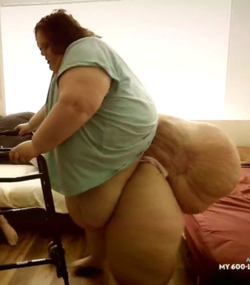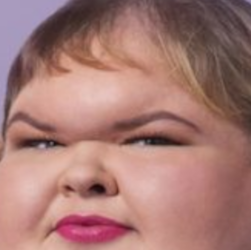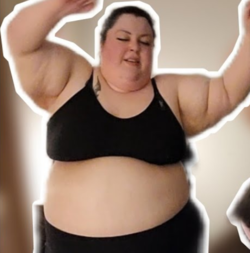Since J's post gave me the opening, I've...thought about back tits:
There are many things about the obese body and its disfigurement
via fat that astonish and horrify me. When I say this, I don't mean uncommon, novel, idiosyncratic disfigurements like Charity's ass-wings:

Or Tammy Slaton's forehead bulge:

Certainly, those things are astonishing and horrifying too but I'm thinking of things that are seen more commonly among fats. For example, the mid-upper arm roll:

I use Virgie Tovar as an example for the sake of expedience but you can find this in day-to-day life wherever fats congregate. Chantal Sarault used to have a mid-upper arm roll as well (though I gather that might not be the case now that she's indulged heavily in cocaine):


The mid-upper arm roll stuns some part of my lizard brain because it naturally understands that, on people who have a normal level of subcutaneous fat, rolls only happen at joint or crease points. No normal, healthy person has a roll in the middle of their upper arm because there is no mid-humerus joint that would allow for even a crease, let alone a
roll, to form. This is, in all cases, a
disfigurement.
My mind reflexively recoils accordingly. Not simply because muh society or muh fatphobic conditioning either. Certainly, having grown up in a place and time where the majority of people were a normal, healthy weight and the overweight (let alone deathfats and megadeathfats) were the outliers that they should be in a healthy society does help to reinforce my instinct. But I also reflexively recoil because I can instinctively intuit what should and should not be possible on the normal human body.
Back rolls are another one of those things for me.

Of course, yadda yadda yadda disclaimer: everyone's fat distribution pattern is genetically determined and this pattern varies widely among individuals. All true but, regardless of the pattern it takes, you have to be carrying significant overweight before you develop
hanging sheets of fat — or even enough fat to form a full roll or much more than a crease — on your back. Certainly, you don't have to carry deathfat levels of overweight, but significant overweight nonetheless. Not simply "Oops, I put on three pounds of fat over the holidays"-levels of overweight. A normal back will actually carry relatively little fat. You might not be able to count ribs, but you should easily be able to feel the solidity of the ribcage under the subcutaneous fat without having to press hard to feel it. You should be able to see the true arc of the ribcage under a normal layer of fat. That, to put it mildly, is not the case with Juliana's back.
I don't pretend I only care about health; health, I think, is paramount but our ability to perceive beauty is a universal human trait and beauty counts for something as well. Disfiguring fat is unlovely, ugly. Leanness and fatness aren't the only metric of beauty, but they're one metric and extremes in that metric — whether we're talking spoopy skellies or megadeathfats — are unlovely. But do young people who have been surrounded by these unnatural disfigurements on one scale or another know that anymore? Will women without Juliana's disfigurements come to be seen as the ugly ones for their rarity? Healthy, normal, lovely (if not beautiful) women are already, statistically, in the solid minority. Have we arrived at some dystopian point in history where grotesque disfigurement is becoming entrenched as normal and possibly even lovely and beautiful? We're living in an episode of
The Twilight Zone if so. Doubly so if we attach the language of power and politics to the celebration of disfigurement and insist that we can no longer call that disfigurement "disfigurement."






